Is There Any Country Where All Drugs Are Legal
This briefing updates our 2016 report on Portugal's groundbreaking reforms, and marks the 20th anniversary of their introduction.
It is also available as a free PDF download.
Background
In 2001, Portugal decriminalised the personal possession of all drugs as part of a wider
re-orientation of policy towards a health-led approach. Possessing drugs for personal use is instead treated as an administrative offence, meaning it is no longer punishable by imprisonment and does not result in a criminal record and associated stigma.1 Drugs are, however, still confiscated and possession may result in administrative penalties such as fines or community service.
Whether such a penalty is applied is decided by district-level panels made up of legal, health and social work professionals, known as 'Commissions for the Dissuasion of Drug Addiction'. Where an individual is referred to a Commission for the first time and their drug use is assessed as non-problematic (low risk), the law requires their case to be 'suspended', meaning no further action is taken. Fines can be issued for subsequent referrals. Where some problematic trends are identified (moderate risk), brief interventions are proposed — including counselling — but these are non-mandatory. In 'high risk' cases, where more serious problematic behaviours and dependence are identified, individuals may receive non-mandatory referrals to specialised treatment services.2
In the vast majority of instances, problematic drug use is not identified, and cases are simply 'suspended'.3 Individuals referred to the Commissions overwhelmingly view their purpose as helping to reduce use and educate on drug risks.4 They are non-judgemental in nature, and a primary focus is safeguarding the right to health of those referred.5
Importantly, the decriminalisation of personal possession is only one part of broader health-centred drug policy reforms that involve an increased focus on harm reduction and treatment provision.6 By 'accepting the reality of drug use rather than eternally hoping that it will disappear as a result of repressive legislation', Portuguese reform allows drugs to be treated as a health, rather than criminal justice, issue.7 The benefits of these reforms, therefore, arise from both decriminalisation itself and the establishment of a wider health-based response to drug problems.
Portugal was not the first country to decriminalise some or all drugs, and it has not been the last.8 However, it is one of the most prominent and influential. The Portuguese model directly influenced the 2020 decriminalisation measure passed in Oregon, for example, as well as proposed decriminalisation in Norway.9 Portugal is regularly held up as the leading example of drug decriminalisation, so understanding the outcomes is vital.
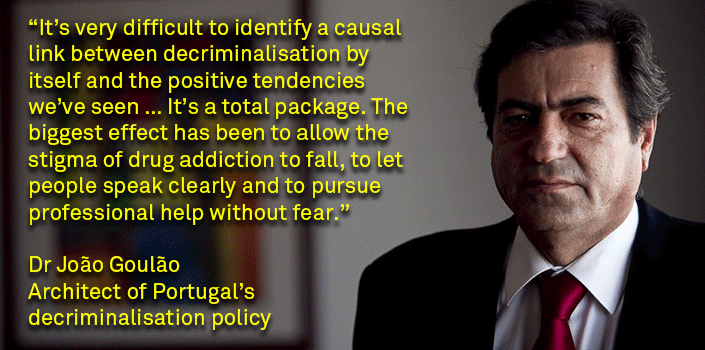
Drug-related deaths
In the first five years after the reforms, drug deaths dropped dramatically. They rose slightly in the following years, before returning to 2005 levels in 2011, with only 10 drug overdose deaths recorded in that year. Since 2011, drug deaths have risen again but remain below 2001 levels (when there were 76 recorded deaths).10
In 2001, Portuguese drug death rates were very similar to the EU average. While rates fell in Portugal following reform, they increased across the rest of Europe in the same timeframe. From 2011 onwards both Portugal and the rest of the EU have trended similarly, rising until 2015/6 — however, the gap between the two remains considerably wider than it was pre-reform. In real terms, drug death rates in Portugal remain some of the lowest in the EU: 6 deaths per million among people aged 15-64, compared to the EU average of 23.7 per million (2019). They are practically incomparable to the 315 deaths per million aged 15-64 experienced in Scotland, which is over 50 times higher than the Portuguese rates.11
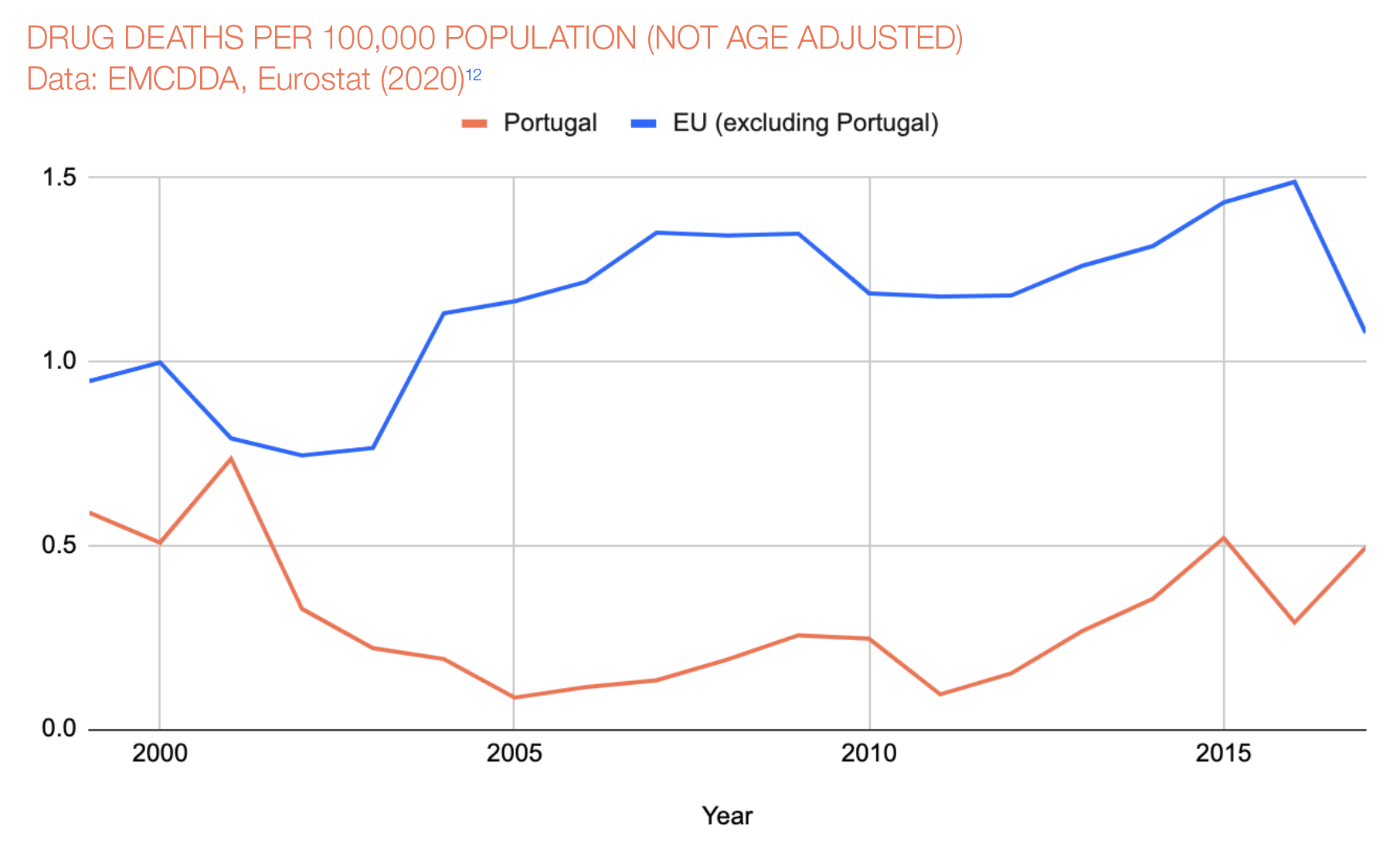
Crime
The move away from criminalising and imprisoning people who use drugs has led to a dramatic change in the profile of the prison population. In 2001, over 40% of the sentenced Portuguese prison population were held for drug offences, considerably above the European average, and 70% of reported crime was associated with drugs.13 While the European average has gradually risen over the past twenty years (from 14 to 18%), the proportion of people sentenced for drug offences in Portuguese prisons has fallen dramatically to 15.7% in 2019 — now below the European average.14
Most of this decline occurred in the first decade following decriminalisation and the establishment of a health-led approach. Since 2010, the actual number of people in prison for drug offences has remained relatively steady, but a rise in overall prison numbers means the proportion of people serving sentences for drug offences has continued to fall.15
It has also been suggested that reform has led to a reduction in drug seizures.16 However, drug seizure data is difficult to analyse so any conclusions should be treated with caution: reduced seizures may be a result of fewer drugs on the market or they may simply be down to reduced police activity.

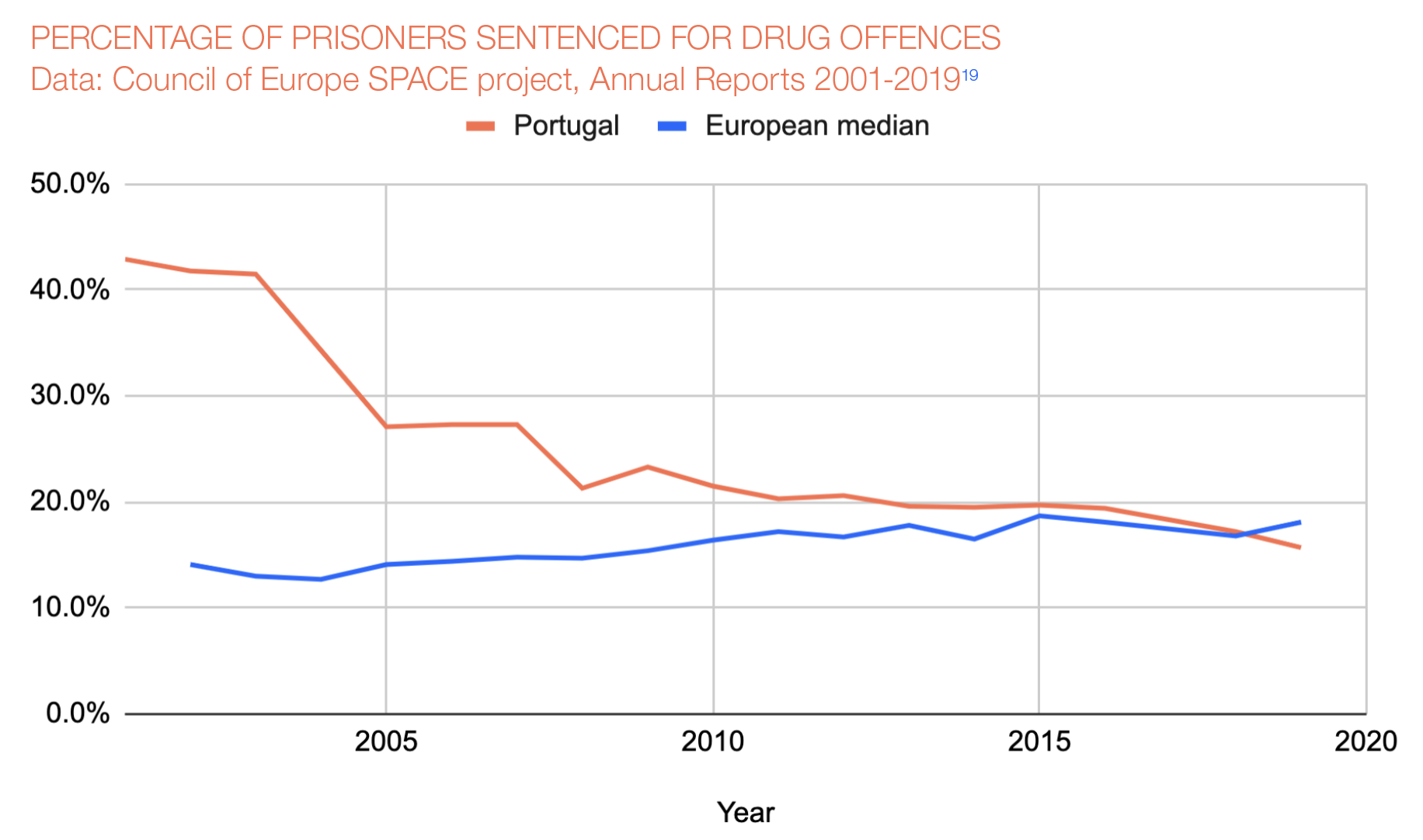
Drug use
Levels of drug use in Portugal have been consistently below the European average over the past twenty years. This is particularly the case among younger people: Portugal has some of the lowest usage rates in Europe among those between the ages of 15-34.17
In the first five years after drug policy reform, use of illegal drugs rose slightly among the general population but fell again in the following five years. Use among 15-24 year olds fell throughout the decade, and among the general population was lower in 2012 than in 2001.
However, consumption trends in Portugal have been keenly disputed and often misrepresented. While drug use during individual lifetimes among the general population appeared to increase in the decade following reform, use within the past 12 months fell between 2001 and 2012. Both the World Health Organization and the United Nations Office on Drugs and Crime consider use in the past 12 months (recent drug use) or within the past month (current drug use) as better indicators of trends among the general population.18
Since 2012, past-year use appears to have risen, particularly among those over the age of 25.20 This is, however, based on relatively limited data from SICAD (the Portuguese drug dependence agency) and only one further dataset — in 2016. In any event, Portugal continues to retain one of the lowest rates of drug use in Europe.
Consumption figures alone tell us relatively little about the level of harm experienced through drug use. A rise in drug use among individuals using only occasionally, and recreationally, is unlikely to lead to large rises in deaths or other harms. For this reason, measuring levels of high-risk drug use, particularly among people who inject drugs, is important.21 As of 2015, there were an estimated 33,290 'high risk' opioid users in Portugal.22 Per 100,000 population, this is above the European average.23 However, it is lower than when decriminalisation was established in 2001.24 Researchers have also noted a fall in the proportion of individuals referred to Dissuasion Commissions found to be dependent on drugs, suggesting a general reduction in problematic drug use — though this may, in part, be linked to police not repeatedly referring the same individuals if they are already in treatment.25 In 2018, 90% of individual cases were found to not demonstrate problematic use.26
Drug policy reform in Portugal was combined with a change in approach to drug education, moving away from abstinence-based 'just say no' campaigns.27 Drug use in schoolchildren has been consistently below the European average for the past twenty years. Rates in 2019 were roughly the same as 2001. In line with European trends, as reported by the European school survey on alcohol and drugs (ESPAD), they have shown a gradual, consistent decline in the last 10 years. ESPAD also reports that perceived availability of drugs among children in Portugal is lower than the European average.28
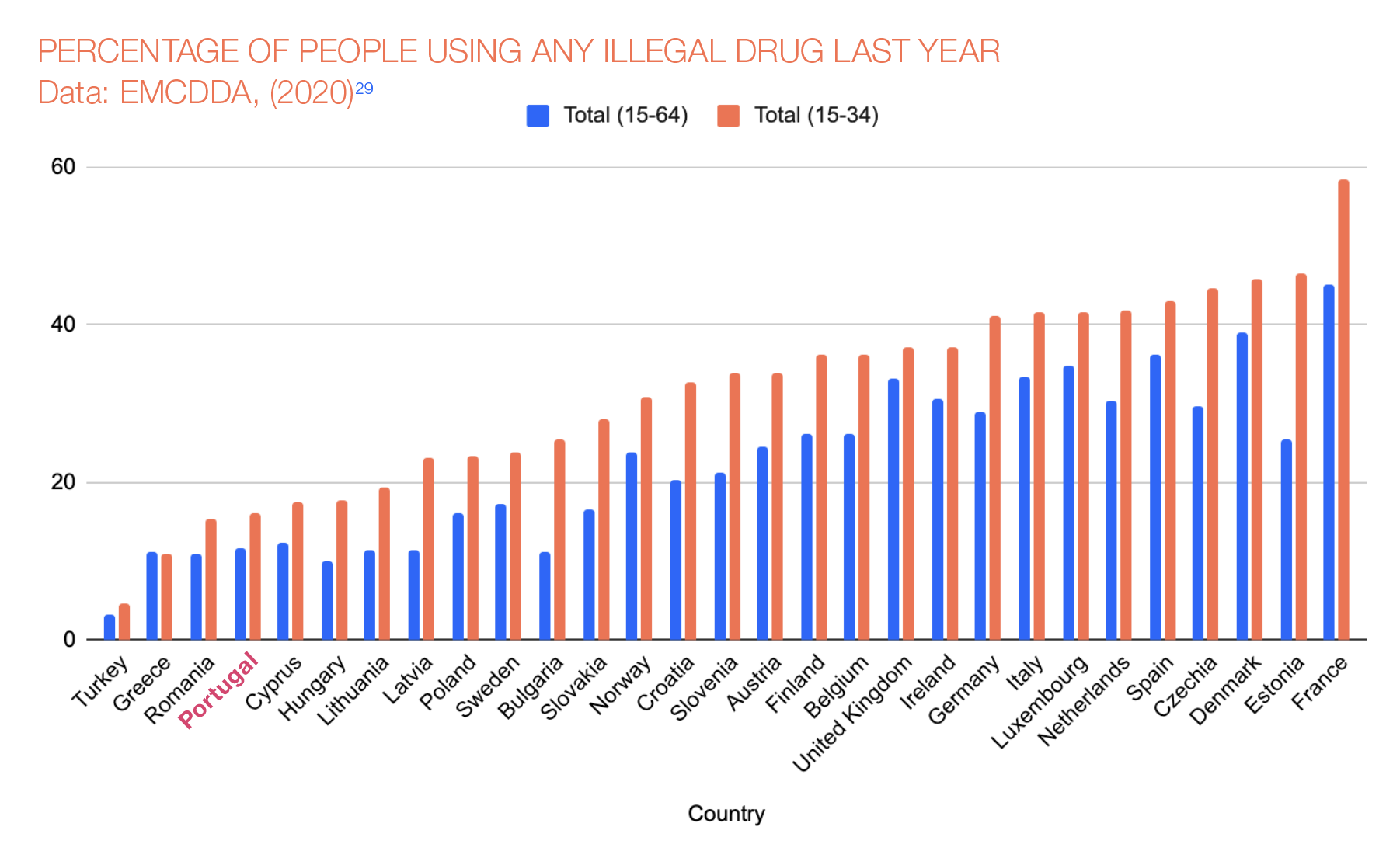
HIV transmission
Drug policy reform in Portugal included wide-reaching needle and syringe programmes aimed at reducing risk of infection among people who inject drugs. In 2001, Portugal had 1,287 new HIV diagnoses attributed to injecting drug use.30 It had over 50% of all new HIV diagnoses attributed to injecting drug use in the EU in 2001 and 2002 despite having just 2% of the EU population. In 2019, with only 16 new diagnoses, it only had 1.68% of the EU total.
While HIV diagnoses have gone down across Europe in this period, the trend in Portugal is much stronger. Owing to its previously extremely high levels of transmission, Portugal retains some of the highest HIV prevalence rates in Western Europe among people who inject drugs (at 13%).31 However, this still marks a significant downturn since the millennium, when half of all new HIV diagnoses were attributed to injecting drug use.32 AIDS diagnoses in people infected through injecting drug use have also fallen dramatically over the past twenty years: from 518 in 2000 to just 13 in 2019. Again, this is a stronger downward trend than the EU average: in 2000 Portugal had 15% of new EU diagnoses; in 2019, it had less than 5%.33
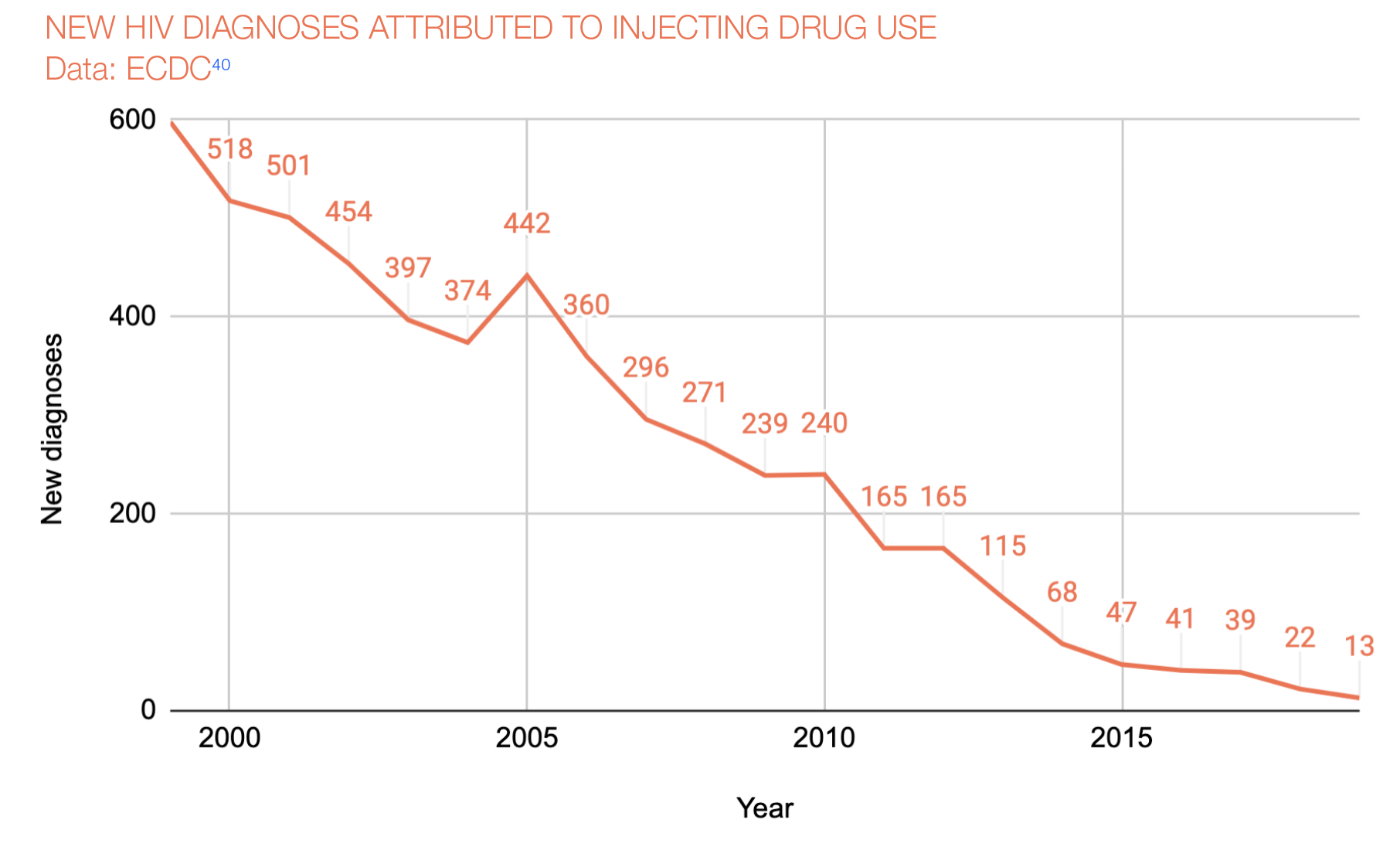
Hepatitis B and C
Hepatitis C prevalence among people who inject drugs has been estimated as the highest in Western Europe and is a result of multiple epidemics in the late 20th century linked in part to unsafe drug injecting practices up to the 1990s.34 Prevalence of hepatitis B (which, unlike hepatitis C, is commonly spread through means other than blood-to-blood contact) is below the Western European average.35 The EMCDDA reports that the number of new yearly hepatitis B and C reports have fallen consistently over the past twenty years.36
Treatment and harm reduction provision
A key feature of the new Portuguese drug policy, alongside decriminalisation, was the expansion of treatment services. Between 2000-2009, outpatient treatment units increased from 50 to 79.37 However, the number of individuals in treatment for drugs steadily decreased between 2009-2018, which may be linked to significant reductions in health and welfare budgets following the impact of the global financial crisis.38 Following the absorption of the country's independent Institute for Drugs and Drug Addiction into the National Health Service (which itself saw budget cuts of 10% in 2012) health spending continued to fall until 2015 — to under 9% of GDP, from roughly 9.9% in 2009.39
A reduction in absolute treatment numbers may also be related to reduced levels of problematic drug use, as discussed above. A study comparing patients entering treatment for heroin dependence pre- and post-reform found an overall decrease between 1992 and 2013, which the authors suggest could be linked to a fall in the number of newly dependent individuals.41 EMCDDA data also indicate a changing profile of individuals entering drug treatment, with admissions for opioids steadily falling over the past ten years but admissions for cannabis going steadily up.42
According to the latest available yearly data there are an estimated 17,246 individuals in opioid substitution treatment in Portugal.43 Using this data, combined with EMCDDA estimates on levels of problematic opioid use in European countries, it can be estimated that over half of people with problematic opioid use in Portugal are in some form of opioid substitution treatment, slightly above the European average.44
Harm reduction has also been a central tenet of the Portuguese drug policy reforms. The latest available data indicate that 1.3 million syringes are being distributed per year. This is significantly down since 2003, when the figure was at 2.6 million, but is still one of the highest in the EU.45 Portugal also has an estimated 2,137 needle and syringe programmes in operation, roughly three times the number of Spain — despite being a quarter of the size in population.46 Nonetheless, some advocates have been 'frustrated by what they see as stagnation and inaction since decriminalisation came into effect', particularly in relation to overdose prevention centres, naloxone provision, and needle and syringe programmes in prison.47 Portugal did finally open its first mobile overdose prevention centres, in Lisbon and Porto, in 2019.48 Other harm reduction efforts have been praised — including in relation to the provision of safer smoking kits — but it is clear that continued investment is needed.49
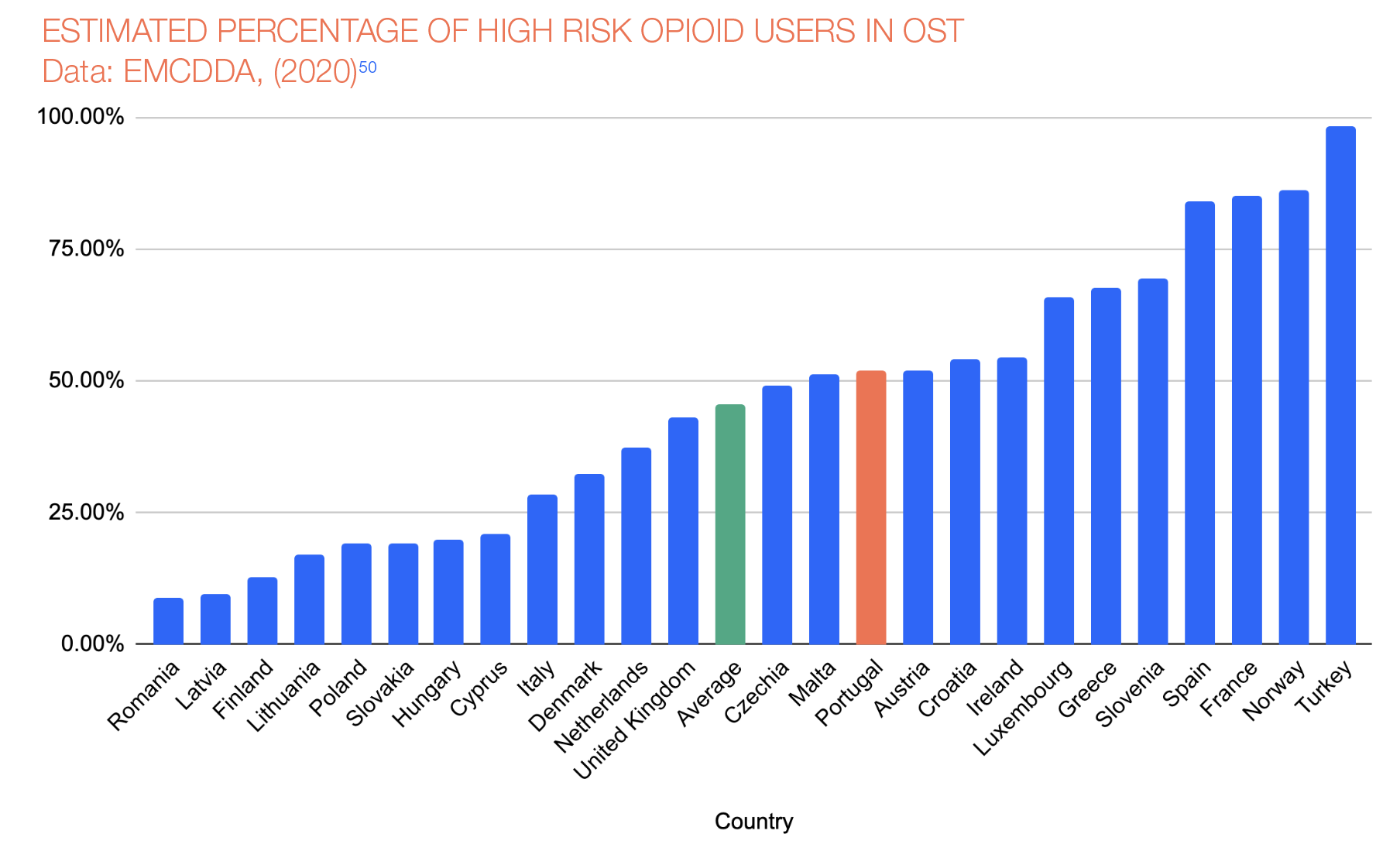
Social costs
A 2015 study found that the social costs of drug use in Portugal fell 12% between 2000 and 2004, and 18% by 2010. While the former figure was largely driven by the reduction in drug-related deaths, the latter was linked to a 'significant reduction' in costs associated with criminal proceedings for drug offences and lost income of individuals imprisoned for these offences.51
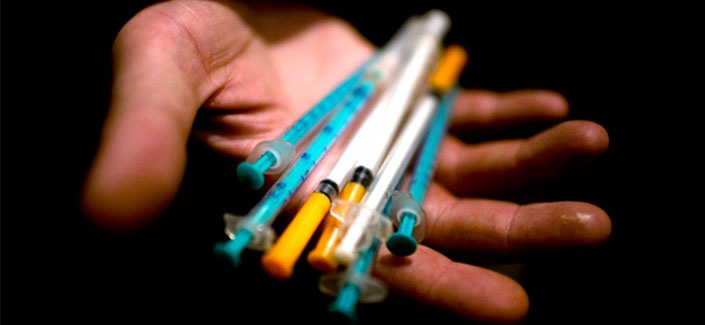
Conclusion
Portugal has set a positive example for what can be done when drug policies prioritise health rather than criminalisation. At the turn of the century, Portugal was facing a crisis, including high levels of HIV infection among people who use drugs. Many impacts of reform were felt immediately: new HIV infections, drug deaths and the prison population all fell sharply within the first decade. The second decade saw slower improvement in key measures, as well as an upturn in drug deaths. However, many of these factors need to be put into context. Drug policy is still only one variable interacting with a complex mix of social, economic, cultural and political factors, and cuts to wider health provision in that period will have played a part in this. Nevertheless, Portugal is in a much better position than it was in 2001 and recorded drug use and drug deaths as a proportion of the general population are both well below the European average.
Portugal's experience is a lesson in what can be achieved when policy innovation and political will are aligned in response to a crisis, and hopefully it will continue to evolve and lead on this issue. However, while ending the criminalisation of people who use drugs is hugely important both in its own right, in reducing stigma and as an enabler of any effective public health response, it only addresses part of the harms caused by prohibition.52 With innovation taking place elsewhere, including regulated cannabis sales in North America and safe supply of opioids and other drugs in Canada, there is also room for Portuguese drug policy to learn from and build upon other reform efforts, and continue in its global leadership role.
References
- 'Personal use' is defined by set thresholds established in law, e.g. 1g for heroin, 2g for cocaine and 25g for herbal cannabis: EMCDDA (2015). Threshold quantities for drug offences. https://www.emcdda.europa.eu/p...
- SICAD et al (2013). Guidelines for the Intervention in Dissuasion. p18-19. http://www.sicad.pt/BK/Publica...
- In 2013, of 7,258 rulings made by Commissions, 83% of processes were suspended temporarily and 5% found the presumed offender innocent: SICAD (2014). 2014 National Report (2013 data) to the EMCDDA by the Reitox National Focal Point. p11. https://www.emcdda.europa.eu/s...
- Carapinha, L. et al (2017). Effects of Dissuasion Intervention, based on CDTs activity. SICAD. http://www.sicad.pt/BK/Estatis...;
- Silvestri, A. (2014). Gateways from Crime to Health: The Portuguese Drug Commissions. Winston Churchill Memorial Trust and Prison Reform Trust. p12, 28. https://www.wcmt.org.uk/fellow...
- Stevens, A. and Hughes, C. (2016). Dépénalisation et santé publique: politiques des drogues et toxicomanies au Portugal. Mouvements 86. https://www.cairn.info/revue-m...
- Pombo, S., & da Costa, N. F. (2016). Heroin addiction patterns of treatment-seeking patients, 1992- 2013: Comparison between pre- and post-drug policy reform in Portugal. Heroin Addiction and Related Clinical Problems 18.6.
- Talking Drugs, Release and IDPC (2020). 29 countries. 49 models of drug decriminalisation. One handy web-tool. https://www.talkingdrugs.org/d...
- Abraham, R. (2021). How Oregon's Radical Decriminalization of Drugs Was Inspired by Portugal. Next City 5 January. https://nextcity.org/daily/ent...; Drug Policy Alliance (2020). Drug Policy Action's Measure 110 Prevails, Making Oregon the First U.S. State to Decriminalize All Drugs & Expand Access to Addiction and Health Services. https://drugpolicy.org/press-r...; Helse- og omsorgsdepartementet (2019) Rusreform – fra straff til hjelp. https://www.regjeringen.no/con...
- EMCDDA (2020). Statistical Bulletin 2020 — overdose deaths. https://www.emcdda.europa.eu/d..., using 'Selection B' data rather than 'Selection D'. The difference between the two methodologies is explained by the EMCDDA here: EMCDDA (2007). Drug-related deaths: Methods and definitions. https://www.emcdda.europa.eu/s...
- EMCDDA (2020). European Drug Report 2020: Trends and Developments. p80. https://www.emcdda.europa.eu/e...; National Statistics and National Records of Scotland (2020). Drug-related Deaths in Scotland in 2019. p85. https://www.nrscotland.gov.uk/...
- Notes:
- Only EU countries were measured in this dataset; EEA countries were excluded. The UK was included in the dataset as it was in the EU for the years measured.
- Death data is taken from: EMCDDA (2020). Statistical Bulletin 2020 — overdose deaths. https://www.emcdda.europa.eu/d..., using 'Selection B' criteria (for difference between the two, see footnote 10). For four countries, however (Cyprus, Greece, Romania and Slovakia), 'Selection B' data was not available, so 'Selection D' was used instead. Death data on either measure was not available for Poland, meaning the EU death rate will be a slight underestimation (as Polish population data have been included but death data have not.)
- Population data was taken from: Eurostat (2020). Population on 1 January by age and sex. https://ec.europa.eu/eurostat/... for both Portugal and the EU. It is based on population on 1 January each year rather than average yearly population, however. The whole country population data is used, meaning the death rates produced for this graph are not age-aggregated. - Torres, A., Mendes, R. et al. (2016). Inquérito Nacional sobre Comportamentos Aditivos em Meio Prisional. Caracterização da população prisional, crimes cometidos e dependências face às drogas, bebidas alcoólicas e jogo a dinheiro. SICAD. p116. http://www.sicad.pt/BK/Estatis...; Cardoso Torres, A. and do Carmo Gomes, M. (2002). Drogas e Prisões em Portugal. Lisboa: CIES/ISCTE. p76. http://www.sicad.pt/PT/Estatis...
- Council of Europe (2001-2019). Space Project: Annual Reports 2001-2019. https://wp.unil.ch/space/space...
- Council of Europe (2001-2019). Space Project: Annual Reports 2001-2019. https://wp.unil.ch/space/space...; SICAD (2017). Statistical Bulletin 2017: Illicit Substances. p10. http://www.sicad.pt/PT/Estatis...
- Félix, S., Tavares, A., and Portugal, P. (2017). Going after the Addiction, Not the Addicted: The Impact of Drug Decriminalization in Portugal. IZA DP 10895. http://ftp.iza.org/dp10895.pdf
- EMCDDA (2020). Statistical Bulletin 2020 — prevalence of drug use. https://www.emcdda.europa.eu/d...
- Hughes, C. E. and Stevens, A. (2012). A resounding success or a disastrous failure: Re- examining the interpretation of evidence on the Portuguese decriminalisation of illicit drugs. Drug and Alcohol Review 31. http://kar.kent.ac.uk/29901/1/...
- Council of Europe (2001-2019). Space Project: Annual Reports 2001-2019. https://wp.unil.ch/space/space...
- SICAD (2014). Statistical Synopsis: Portugal 2014. p3. http://www.sicad.pt/BK/Estatis...
- Hughes, C. E. and Stevens, A. (2012). A resounding success or a disastrous failure: Re- examining the interpretation of evidence on the Portuguese decriminalisation of illicit drugs. Drug and Alcohol Review 31. http://kar.kent.ac.uk/29901/1/...
- EMCDDA (2019). Portugal, Country Drug Report 2019. https://www.emcdda.europa.eu/p...
- EMCDDA (2020). Statistical Bulletin 2020 — problem drug use. https://www.emcdda.europa.eu/d...
- Stevens, A. and Hughes, C. (2016). Dépénalisation et santé publique: politiques des drogues et toxicomanies au Portugal. Mouvements 86. https://www.cairn.info/revue-m...; Pombo, S., & da Costa, N. F. (2016). Heroin addiction patterns of treatment-seeking patients, 1992- 2013: Comparison between pre- and post-drug policy reform in Portugal. Heroin Addiction and Related Clinical Problems 18.6.
- Stevens, A. and Hughes, C. (2016). Dépénalisation et santé publique: politiques des drogues et toxicomanies au Portugal. Mouvements 86. https://www.cairn.info/revue-m...
- SICAD (2020). Statistical Bulletin 2018: Illicit Substances. p7. http://www.sicad.pt/BK/Estatis...
- Roy, L. (2018). 'It Starts With Mindset': What Portugal's Drug Policy Experts Taught Me About Addiction Treatment. Forbes 31 August. https://www.forbes.com/sites/l...;
- See graph below: this graph data is based on 1995-2015 results documented in ESPAD's 2015 report and subsequent data in its 2019 report: ESPAD (2015). Trends across 25 countries. http://www.espad.org/report/tr...; ESPAD and EMCDDA (2020). ESPAD Report 2019: Results from the European School Survey Project on Alcohol and Other Drugs. p49, p37-38. https://www.emcdda.europa.eu/p...
- EMCDDA (2020). Statistical Bulletin 2020 — prevalence of drug use. https://www.emcdda.europa.eu/d...
- EuroHIV (2004). HIV/AIDS Surveillance in Europe: End of year report, 2004 no.70. p13. HIV surveillance reports 2007-2020 are available here, but older versions produced by EuroHIV including the 2003 report are archived and available by contacting ECDC: https://www.ecdc.europa.eu/en/....
- Harm Reduction International (2020). Global State of Harm Reduction 2020. p176. https://www.hri.global/global-...
- EuroHIV (2004). HIV/AIDS Surveillance in Europe, End-year report 2003 no. 70. P11; Instituto da Droga e da Toxicodependência (2004). A Situação do País em Matéria de Drogas e Toxicodependências, Relatório Anual – 2003 (Vol 1). p35. http://www.sicad.pt/PT/Publica...
- ECDC (2007-2020). HIV Surveillance Reports. https://www.ecdc.europa.eu/en/...; EuroHIV (2004). HIV/AIDS Surveillance in Europe: End of year report, 2004 no.70. p27. Data is often added retrospectively, meaning that previous years' data are often amended in subsequent reports. For this graph, therefore, the most recently recorded data is used in each instance.
- Palladino, C. et al (2018). Epidemic history of hepatitis C virus genotypes and subtypes in Portugal. Scientific Reports 8. https://www.nature.com/article...
- Harm Reduction International (2020). Global State of Harm Reduction 2020. p176. https://www.hri.global/global-...
- EMCDDA (2020). Statistical Bulletin 2020 — drug-related infectious diseases. https://www.emcdda.europa.eu/d...
- Stevens, A. and Hughes, C. (2016). Dépénalisation et santé publique: politiques des drogues et toxicomanies au Portugal. Mouvements 86. https://www.cairn.info/revue-m...
- SICAD (2020). Statistical Bulletin 2018: Illicit Substances. p6. http://www.sicad.pt/BK/Estatis...
- Khalip, A. (2012). Once a model, crisis imperils Portugal's drug program. Reuters 13 August. https://www.reuters.com/articl...; World Health Organization (Accessed January 2021). Global Health Expenditure Database. https://apps.who.int/nha/datab...
- ECDC (2007-2020). HIV Surveillance Reports. https://www.ecdc.europa.eu/en/...; EuroHIV (2004). HIV/AIDS Surveillance in Europe: End of year report, 2004 no.70. p27. Data is often added retrospectively, meaning that previous years' data are often amended in subsequent reports. For this graph, therefore, the most recently recorded data is used in each instance.
- Pombo, S., & da Costa, N. F. (2016). Heroin addiction patterns of treatment-seeking patients, 1992- 2013: Comparison between pre- and post-drug policy reform in Portugal. Heroin Addiction and Related Clinical Problems 18.6.
- EMCDDA (2019). Portugal Country Drug Report 2019. p21. https://www.emcdda.europa.eu/s..
- EMCDDA (2020). Statistical Bulletin 2020 — health and social responses. https://www.emcdda.europa.eu/d...
- EMCDDA (2020). Statistical Bulletin 2020 — problem drug use. https://www.emcdda.europa.eu/d...; see also above footnote.
- EMCDDA (2020). Statistical Bulletin 2020 — health and social responses. https://www.emcdda.europa.eu/d...
- Harm Reduction International (2020). Global State of Harm Reduction 2020. p176. https://www.hri.global/global-...
- Ferreira, S. (2017). Portugal's radical drugs policy is working. Why hasn't the world copied it? The Guardian 5 December. https://www.theguardian.com/ne...
- Taylor, H. et al (2019). Prospective client survey and participatory process ahead of opening a mobile drug consumption room in Lisbon. Harm Reduction Journal 16. https://harmreductionjournal.b...
- Harm Reduction International (2020). Global State of Harm Reduction 2020. p21. https://www.hri.global/global-...
- EMCDDA (2020). Statistical Bulletin 2020 — problem drug use. https://www.emcdda.europa.eu/d...; EMCDDA (2020). Statistical Bulletin 2020 — health and social responses. https://www.emcdda.europa.eu/d...
- Gonçalves, R., Lourenço, A. and Silva, S. N. (2015). A social cost perspective in the wake of the portuguese strategy for the fight against drugs. International Journal of Drug Policy 26 199–209. https://pubmed.ncbi.nlm.nih.go...
- INPUD (2018). Is Decriminalisation Enough? Drug User Community Voices from Portugal. https://www.inpud.net/en/decri...
Take
action
Support transform
The time is right for real reform of our drug laws – and you can help. Please support us by giving what you can.
Is There Any Country Where All Drugs Are Legal
Source: https://transformdrugs.org/blog/drug-decriminalisation-in-portugal-setting-the-record-straight
0 Response to "Is There Any Country Where All Drugs Are Legal"
Post a Comment